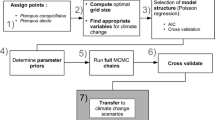Abstract
Hendra virus, a novel member of the family Paramyxovirus that has emerged from bats in Australia, causes fatal disease in livestock and humans. Eleven spillover events have been identified since the first description of the virus in 1994, resulting in a total of 37 equine cases and six human cases. All human cases have been attributed to exposure to infected horses; there is no evidence of bat-to-human or human-to-human transmission. Low infectivity and a high case fatality rate are features of Hendra virus infection in both horses and humans. The temporal pattern of spillover events suggests seasonal factors (plausibly be environmental, biological or ecological) as the proximate triggers for spillover. Minimisation of the future occurrence and impact of Hendra virus infections requires an understanding of the ecology of flying foxes, of virus infection dynamics in flying foxes, and of the factors that promote spillover. Management strategies seek to minimize the opportunity for effective contact between bats and horses, and limit potential horse-to-horse and horse-to-human transmission. Incomplete knowledge of the ecology of the virus, of the proximate factors associated with spillover, and the inherent difficulties of effectively managing wild populations, preclude a management approach targeted at bats.
Similar content being viewed by others
References
Anon. 2008. Guidelines for Veterinarians Handling potential Hendra Virus infection in Horses. Work Instruction. 2 ed. Brisbane, Australia: Department of Primary Industries & Fisheries, Queensland.
Anon. 2008. Hendra virus: Important information for horse owners. DPI&F Factsheet. Brisbane, Australia: Department of Primary Industries & Fisheries, Queensland.
Daszak P, Cunningham A, Hyatt A. 2001. Anthropogenic environmental change and the emergence ofinfectious-diseases in wildlife. Acta Tropica, 78:103–116.
Field H, Barratt P, Hughes R,et al. 2000. A fatal case of Hendra virus infection in a horse in north Queensland: clinical and epidemiological features. Aust Vet J, 78:279–280.
Field H, Breed A, Shield J,et al. 2006. Epidemiological perspectives on Hendra virus infection in horses and flying foxes. Aust Vet J, 85:268–269.
Field H E, Mackenzie J. 2004. Novel viral encephalitides associtated with bats (Chiroptera) — host management strategies. Arch Virol, 18(Suppl):113–121.
Field H E, Schaff K, Kung N,et al. 2009. Hendra virus outbreak with novel clinical presentation, Queensland, Australia 2008. Emerg Infect Dis, (Submitted).
Mackenzie J, Field H, Guyatt K. 2003. Managing emerging diseases borne by fruit bats (flying foxes) with particular reference to Henipaviruses and Australian bat lyssavirus. J Appl Microbiol, 94S:59S–69S
Morse S S. 1995. Factors in the emergence of infectious diseases. Emerg Infect Dis, 1:7–15.
Murray K, Selleck P, Hooper P,et al. 1995. A morbillivirus that caused fatal disease in horses and humans. Science, 268:94–97.
O’sullivan J D, Allworth A M, Paterson D L,et al. 1997. Fatal encephalitis due to novel paramyxovirus transmitted from horses. Lancet, 349:93–95.
Parry-Jones K, Augee M. 2001. Factors affecting the occupation of a colony site in Sydney, New South Wales by the Grey-headed Flying-fox Pteropus poliocephalus (Pteropodidae). Austral Ecol, 26:47–55.
Plowright R K, Field H E, Smith C,et al. 2008. Reproduction and nutritional stress are risk factors for Hendra virus infection in little red flying foxes (Pteropus scapulatus). Proc Biol Sci, 275:861–869.
Selvey L, Wells R M, McCormack J G,et al. 1995. Infection of humans and horses by a newly described morbillivirus. Med J Aust, 162:642–645.
Author information
Authors and Affiliations
Corresponding author
Rights and permissions
About this article
Cite this article
Field, H. Hendra virus re-visited. Virol. Sin. 24, 105–109 (2009). https://doi.org/10.1007/s12250-009-3034-3
Received:
Accepted:
Published:
Issue Date:
DOI: https://doi.org/10.1007/s12250-009-3034-3




